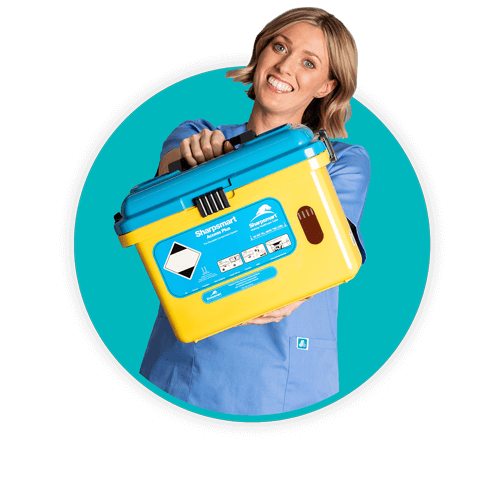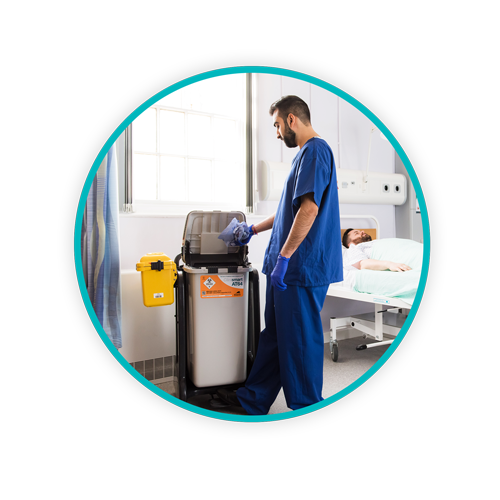Case Study: Cutting Carbon Emissons

A life cycle assessment study performed to compare safety engineered sharps containers with single-use containers on 10 sites across the UK proved that the introduction of the Sharpsmart system demonstrated a 32% average reduction in sharps waste and a 91% average reduction in CO2 emissions year on year. The 12-month study was performed by Sharpsmart and Waterman Environmental and compared the use of single-use sharps bins and Sharpsmart safety engineered collectors at Sheffield Teaching Hospitals NHS Foundation Trust, University Hospital of North Staffordshire NHS Foundation Trust, Winchester & Eastleigh Healthcare NHS Trust, and Chesterfield Royal Hospital NHS Foundation Trust.
Sharpsmart’s safety engineered sharps containment system is not only proven to be the best sustainable alternative to single-use disposal containers, but also ensures that its NHS customers meet the requirements of the NHS Procurement Strategy and The Climate Change Act (2008) to reduce CO2 emissions by 80% by 2050.
In this blog:
- The Challenge: Reducing CO2 Emissions
- Our Approach: Reducing Demand and Reducing 'In Use' Emissions
- Our Solution: Substition and Innovation
- The Results: Supply Chain Management
As a safety engineered sharps safety device the Sharpsmart system eliminates the need to incinerate packaging (sharps containers) which, as the 10-site study proved, constitutes approximately 32% of the sharps waste stream. In addition, the CO2 emissions associated with the manufacture and transport of raw material and finished goods is massively reduced (by 91%). The outstanding conclusion of the 10-site study was that there is significantly more CO2 generated during the manufacturing and disposal phase of the single-use bin than is generated to dispose of the sharps waste which they are designed to hold. In other words, the NHS generates more CO2 to produce and dispose of the sharps packaging material than it does to meet its end goal of disposing of the medical sharps. All CO2 generating phases of the Sharpsmart service were also considered in the study which included manufacture of raw materials and Sharpsmart containers; transport of the containers throughout manufacture, supply, and return to processing sites; the cleaning of the units; and the recycling of expired Sharpsmart units.
The NHS procurement toolkit Procuring for Carbon Reduction sets out a hierarchy of interventions that should be considered when purchasing goods and supplies. Sharpsmart sharps containers are proven to reflect this commitment towards the environment by meeting these procurement interventions at every stage.

Reducing Demand
-
The most effective way to reduce carbon emissions is to reduce the amount of goods or services consumed/procured.
-
Unnecessary wastage can be created through overstocking, lack of operational management control, or poor supply chain practices.
Sharpsmart’s safety engineered sharps containers are supplied in an optimised range of sizes, enabling you to select the container best suited to your needs but minimising the number and types of containers required. The Sharpsmart range includes point-of-use and bulk disposal units (where high volumes of sharps are produced)
Reducing ‘In Use’ Emissions
-
Focussing on embedded CO2 emissions associated with goods and services can help reduce whole-life costs as well as the carbon footprint.
-
The Sharpsmart/Waterman commissioned Life Cycle Carbon Footprint demonstrated significant carbon savings using Sharpsmart, compared to the industry standard single-use sharps containers.

Substitution and Innovation
- It is often possible to meet a need in a different way which effectively reduces the carbon footprint.
- Substituting Sharpsmart safety engineered sharps containers for the conventional single-use disposable containers can deliver average lifetime CO2 reductions of 91% per year.
-
This helps deliver the 80% total emissions reduction required by the NHS to comply with the Climate Change Act 2008.

Supply Chain Management
-
Sharpsmart utilises its purpose designed Washsmart system to empty, clean, and sanitise the safety engineered Sharpsmart containers and manage all logistical aspects of the service.
-
This ensures localised coverage of customer sites, minimising CO2 generation throughout the in-use phase of the service.

The Sharpsmart systems and the associated auditing system, Auditsmart, ensures compliance with NHS' Safe Management of Healthcare Waste Guidelines (HTM 07-01), and a bespoke life cycle
assessment study tool will support the NHS Procurement Strategy by consistently demonstrating that significant reduction in greenhouse gas emissions are achieved from the initial stages of the procurement process by utilising data gathered from over 40 Sharpsmart user sites across the UK. Sharpsmart provides an ongoing commitment towards safety, sustainability, value and regulatory compliance.


